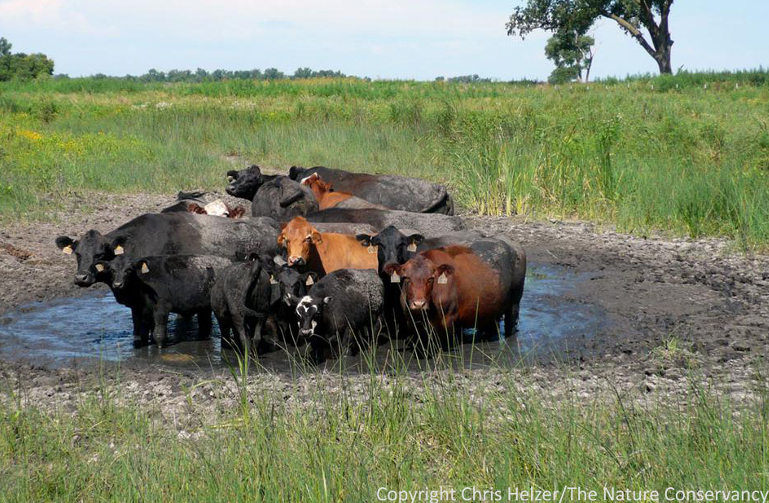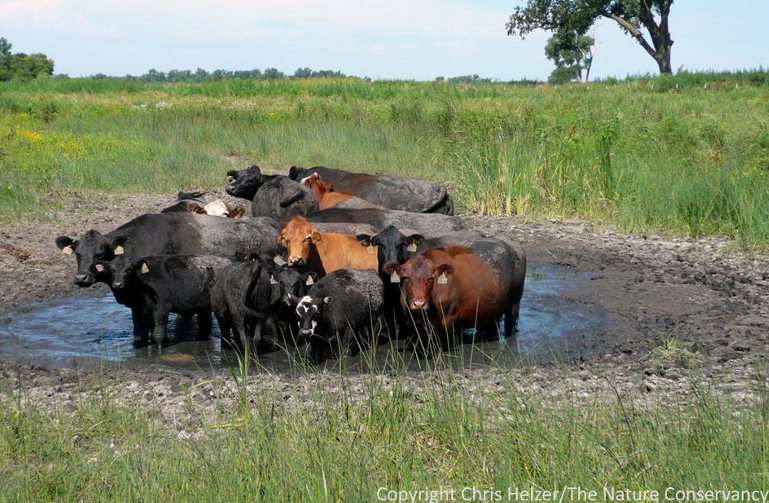Though I have no personal aspirations of the farming or ranching kind, own neither property measured in acres nor livestock, and in fact eat no fish or meat (though I do eat dairy and eggs), I check in frequently with Soil4Climate, a Facebook group devoted to soil carbon sequestration and holistic grazing. I’ve learned a huge amount from the folks that post there, and enjoy the online conversation. It serves as a useful antidote to the news of destruction that emanates from so many places and sources on our beleaguered planet.
Even here, however, peace does not prevail. To me—urban gardener, land restorationist and soil carbon sequestration advocate—the theory and practice of holistic grazing makes so much sense for certain ecosystems that I’ve been startled to discover an ongoing, multi-faceted, sides-must-be-taken debate about holistic grazing’s efficacy in restoring ecosystem biodiversity while sequestering carbon in the soil. And then the ecological merits of eating/not eating meat get thrown in for good measure. Holistic grazing proponents say, “We need more domesticated grazing animals. They will return ecosystems to health and will help save the planet by storing carbon.” Naysayers insist that holistic grazers are overstating their claims and that results by practical experts like Allan Savory can’t be replicated following the rules of scientific experimentation, so it all must be bunk. Some folks combine a defense of holistic grazing with slamming veganism and big green environmentalism, even going so far as to claim that conservation and protection of land from overgrazing flat out doesn’t work. Then there is the ongoing discussion—actually, shouting row—about whether eating less—or no—meat is actually more carbon friendly than omnivory; unfortunately militant vegans and vegetarians can and do grow strident in their anti-meat and therefore anti-livestock efforts. In few places in these types of discussions have I so far come across more than a glancing mention of the needs of wild, non-anthropocentric ecosystems, or the effects of excessive human population on natural ecosystems and their inhabitants, though other literature is replete with research and examples. Perhaps I haven’t looked far enough.

Like many such debates, particularly in the ghostly, Hades-like landscape of the internet, the whole discussion becomes one of those exercises in which participants often seem more interested in taking sides, scoring points, proving another party wrong, finding one right answer, or accusing others of not following rules. Partisanship takes precedence over problem/solution centered discussion. Examples from one geographic location are sometimes used in the quest to prove or disprove arguments, ignoring that they might not be valid applied elsewhere and under different circumstances. It seems as though once people take sides much nuanced, localized, particularized truth gets lost. Depending on where the debaters stand, holistic grazing becomes the one-size-fits-all solution for what ails the earth or completely bogus; meat-eaters-vegans-vegetarians are bad, depending; and what does or doesn’t work in a desert or temperate zone will/won’t work elsewhere.
However, messy, complex, nonlinear reality doesn’t match the rhetorical strategies of argument or the rule-bound rigor of science. It would be good to remember that no matter how ingenious a system of farming or land management might be, it will not cover every situation on earth for the simple reason that while the biosphere (aka Gaia) may follow the general physical laws of physics and ecology, it is a self-regulating, interactive system with synergistic, emergent properties that is constantly experimenting, and, when facing a particular problem, comes up with a multiplicity of answers. The same goes for humankind, that most adaptive and disruptive of species, from the individual to whole cultures. From the Paleolithic to the present, the range of geographically and culturally determined human dietary choices has always been vast; there is room in this wide world for vegans and meat-centric omnivores alike. And while most ecosystems on earth are indeed fraying, largely thanks to our efforts, holistic grazing may or may not be the particular answer a particular piece of land needs to regenerate, its ecosystem to thrive and its inhabitants (including humans) to flourish.
The central, overarching question on which all sides apparently agree is this: To avoid disastrous climate change and environmental destruction, how are we humans to manage our land such that the land regenerates, biodiversity increases, and carbon is sequestered? The only real answer—how we solve the problem depends completely upon where we live—might not seem very satisfactory. It is certainly not easy. This answer yields a multiplicity of solutions that added up together might address the larger problem in a way befitting the complexity of the self-governing, self-regulating biosphere, which does not trade in absolutist ideologies or ethical systems. Such management may or may not properly include grazing. It may or may not also include: conservation; protection; active restoration—whether conservative and historical or creative; rewilding; or an ecosystem appropriate form of regenerative agriculture, whether ranching, silvo-pasturing, mixed farming, forest gardening, or any of a number of other ecosystem-specific alternatives. As far as I can tell, it doesn’t involve Confined Animal Feeding Operations or telling people they must or must not eat meat.
To me, it is much more much more interesting and useful to learn about what works for people (and other species) in particular locales (in the hope of learning and adapting ideas to one’s own ecosystem) than reading about why other folks are wrong. Thus, in the spirit of problem-centered discussion, I offer the following guidelines that, while abstract, hopefully would encourage people to begin with the land itself and with a spirit of inquiry that would enable them to test whether various land management styles might be appropriate in a particular situation. They are based on my own experience and study. Most veteran land managers not involved in purely industrial farming or standardized corporate-campus style landscaping will find them blindingly obvious. Nevertheless, here they are.
The goal for any piece of land:
All six kingdoms of life working together above and below ground to create a biodiverse, thriving ecosystem that supports the resident species, human and non-human alike, while contributing to the overall biosphere’s ongoing project of operating its systems in such a way as to support life on earth.
The guidelines:
The following four guidelines, as far as I can tell, will work at any scale, from the small urban garden to vast holdings and are adaptable to nearly every situation that involves people, plants and animals. You’ll notice there is nothing about the question of how much meat we should or should not be eating or whether holistic grazing is the be-all, end-all answer to land restoration and carbon sequestration. After all, if you ask an ecosystem a question, the answer invariably will be “it depends.”
1. Take time to learn your physical ecosystem, including its history, present conditions and possible future changes due to climate change or other factors.
Where do you live? What is the climate, elevation, rainfall, terrain, soil composition? How big is the piece of land you are working with? What is its current condition? How was it used before? What is the context, for example, is it rural or urban? What is its human and non-human history in both near and deep time? What non-human plant and animal species reside in the area? Have they been there a long time, or were they introduced recently? How has the climate changed lately and how is it likely to change in coming years? These are just a few of the questions that could be asked by anyone planning to inhabit and work with a piece of land. Failure to ask these questions and simply imposing the human need to exploit the land has led to improper management, including deforestation, overgrazing, and desertification, all of which have caused, besides ecosystem destruction, much human misery up to and including the destruction of empires for thousands of years. In 5000 BC, a civilization collapsed in the Near East because of deforestation and overgrazing, leading to a change in the local hydrology and consequent crop failures over time, and desertification that still exists today. In the US, we had the dustbowl in the 1930s from which parts of the southwest have not fully recovered. As Jared Diamond and many others have documented, and modern landscape studies confirm using modern tools such as aerial photography, this story has repeated itself whenever and wherever humans have settled, practiced agriculture and built sedentary urban centers while increasing their populations.
The preliminary discoveries to your investigations will lead naturally to guideline two, as you begin to make decisions about what to do with your piece of land. The answers might point in a different direction than first expected, even if all the neighbors are managing their property a certain way, or you are an adherent of a particular style or system of land management, or a particular local tradition. On the other hand, a pre-industrial method, possibly combined with modern tools and knowledge might be exactly right.
For just one example, there is a vast difference between a naturally occurring desert and a formerly vegetated area that has been overgrazed or farmed to the point of desertification; between a naturally arid (but possibly non-desert) area where large ungulates were non-existent prior to human settlement and a grassland that once hosted a constellation of animal species including grazers and predators; or a woodland/savanna matrix once and possibly still home to grazers, that has now been overgrazed because either natural predators have been extirpated or humans pack too many animals on the land and don’t practice holistic grazing.
2. Adjust your management to what you have learned, both from the land itself and through study, understanding that as you learn more and see how the land reacts to what you are doing, more adjustments will be required
Adaptive management is paramount. What matters most: geographic location, ecosystem type, how damaged the land is and what the damaging factors are. Once that has been assessed, beginning decisions can be made, implemented, tested. Then further actions will build on what works. The designing, planning and implementation structure is more like a tree, or the permaculturalists’ four dimensional spiral than an architectural drawing or engineering design. We are dealing with complex, self-organizing systems, not building a complicated mechanical structure. Ideally we are working to help the system to exercise its own positive, beneficial feedback loops rather than remake it. Because the biosphere is self-regulating whole, I believe that smaller ecosystems are capable of “learning” as they self-regulate and adapt to our efforts to help them regenerate while possibly, as it happens, engaging in human–serving agricultural or gardening activities.
Whether or not protection works depends entirely on the situation—whether the native seed bank is at least somewhat intact or not, what the surrounding landscape is like and the habits of the native plants. Leaving an area alone for a while, as forest gardeners traditionally have done as part of the milpa farming cycle might work. Simple protection might work in an overgrazed (by deer) temperate woodland—I’ve seen this happen when areas have been fenced to protect them from deer—the trilliums come back! But perhaps in the desert this might not work, since it might be more difficult for desert ecosystems to regenerate. The same goes for former industrial sites or other seriously degraded land. In my part of the world, protection—say leaving an old field or a natural area strictly alone might or might not work, depending on whether or not the native seed bank is intact. Most likely quickly colonizing invasive plants will beat slower to start natives (if, indeed there are any in the seedbank). Very active management will be necessary.
In some places, “protected” grasslands from which the historic wild ungulates and the cattle that replaced them have been removed, good restoration and carbon sequestration requires repopulation either by native species, carefully managed domestic livestock or a mix. And to really make this work, other animals, from birds to small mammals and insects, and a regenerating soil biota are also required.
3. Set aside a third of the land (at least) for the use of wild, non-human species—areas that, if, as may be necessary, are managed, are not managed primarily for human purposes
Somehow a balance must be struck between our needs for cities, gardens, grazing and agriculture and the habitat needs of non-human-connected animals. It doesn’t seem right that we, and our livestock, not to mention mines and factories, buildings and roads, have commandeered so much of the planet. If possible, that third should connect up with other set-aside lands to form corridors connecting large natural areas such as state or national parks, or on an even larger scale, seasonal homes to migrating or widely foraging species, whether sandhill cranes, monarch butterflies or grizzly bears. A third might seem like a lot, especially on valuable, productive land, but if approached correctly, it will be less difficult than it seems. In an urban garden, it’s easy to plant more native flowers and have less lawn. On a farm, fencerows, pollinator buffer zones, and re-naturalizing any stream banks into riparian ecosystems will go a long way towards fulfilling that requirement—and of course natural areas often offer rewards to human inhabitants such as nuts and berries, mushrooms and wood, or wild game.
It might seem odd to place such importance on this guideline, especially where there might seem to be more wilderness than human-dominated landscape, but it is crucial, and becomes more important as human population increases and more land is brought under human control. This guideline does not obviate the necessity to incorporate native species and habitat areas into our heavily-managed-for-human-needs domain as well, everywhere from suburban parks to the inner cities. Set-aside lands can’t do it alone.
4. Pay attention to the local native pollinators
If bumblebees and other native bees and butterflies are thriving, then something is going right. There are native bees on every continent except Antarctica and they are some of the primary indicator species of a healthy ecosystem, as are butterflies and certain birds. It’s all too easy for most of us to forget that humankind is not a keystone species. We are not even an indicator species, except negatively: when there are too many of us using too many of an ecosystem’s resources while letting our waste pile up, we degrade it, if not wreck it outright, regardless of nearly any culture and technology level you care to discuss. That being said, I do not subscribe to the view that we are a plague on the earth. We humans are able to study and articulate our thoughts about the universe and the biosphere within which we live in a way no other species does that we’ve discovered so far. This does not make us particularly special, but that awareness does give us the responsibility, when we realize we are overstepping boundaries or causing problems, to see what can be done to help an ecosystem revitalize. For example, if we learn, as we have, how to help people live longer, healthier lives and more of our babies survive to adulthood, then we have a responsibility to limit how many babies we have; and we know enough to know how do this in non-deadly, non-coercive ways. Otherwise, the earth will do it for us, dreadfully. The needs of the greater biosphere always trump the needs of humanity.
Forests, grasslands, rivers and mountains and all the living creatures therein are another way the self-creating biosphere expresses itself. They form ecosystems and bioregions structured by living organisms that define and enable life on this planet. Who are we to have the temerity to willingly wreck them and kill the non-human creatures that populate them? Who are we, for example, to say that our need for copper is more important than the right of the Boundary Waters to be free of toxic mine wastes, that the tall grass prairie/savanna complex has no right to exist because we need corn and soy, or that the Colorado River has no right to reach the sea?
To return to pollinators. In the US, the graceful monarch butterfly and fuzzy, cute native bumblebees are under threat mainly because we have destroyed its habitat throughout the entire middle section of our country. The same is true for myriad other species, of course, belonging to all the orders of life. Butterflies and bees not only are keystone species (without them ecosystems collapse), but they are also indicator species, the little creatures that signal health in an ecosystem. If, when you are managing a piece of land, you do things in such a way that there is an increase of butterflies, and native bumble and solitary bees, and there are more birds of diverse species, then you are on your way to helping heal the land, whether or not you are employing holistic grazing or any other specific management system.
Note: The photo was taken by Chris Helzer, whose blog The Prairie Ecologist is always worth reading.






